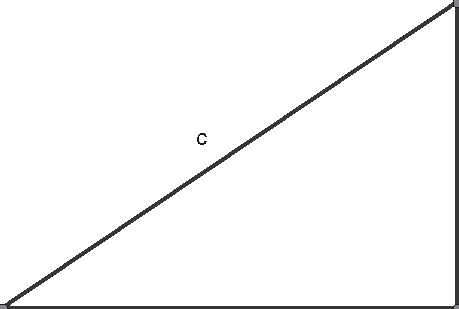Geometry: And the Rest
And the Rest
There are three other trigonometric ratios that I will just mention. These three new ratios actually come from the first three ratios.
The tangent of an angle is the ratio of the length of the side opposite the angle divided by the length of the adjacent side. The cotangent of the angle is just the reciprocal of the tangent ratio. The cotangent of an angle is the ratio of the length of the adjacent side divided by the length of the side opposite the angle.
The sine of an angle is the ratio of the length of the side opposite the angle divided by the length of the hypotenuse of the triangle. The cosecant of the angle is the reciprocal of the sine of the angle. The cosecant of an angle is the ratio of the length of the hypotenuse of the triangle divided by the length of the side opposite the angle.
The cosine of an angle is the ratio of the length of the adjacent side divided by the length of the hypotenuse of the triangle. The secant of the angle is the reciprocal of the cosine of the angle. The secant of an angle is the ratio of the length of the hypotenuse of the triangle divided by the length of the adjacent side.
Solid Facts
In a right triangle, the cotangent of an angle is the ratio of the length of the adjacent side divided by the length of the side opposite the angle.
In a right triangle, the cosecant of an angle is the ratio of the length of the hypotenuse of the triangle divided by the length of the side opposite the angle.
In a right triangle, the secant of an angle is the ratio of the length of the hypotenuse of the triangle divided by the length of the adjacent side.
Because the cotangent, cosecant, and secant ratios of an angle are just the reciprocals of the tangent, sine, and cosine ratios, the properties of these new ratios fall out from the properties of the old ratios. For example, because the sine of an angle cannot be greater than 1, the cosecant of an angle cannot be less than 1.
There is an important relationship between the sine and cosine ratios that comes from the Pythagorean Theorem. Given a right triangle, like that shown in Figure 20.8, the Pythagorean Theorem tells us a2 + b2 = c2. If you divide both sides of this equation by c2, you have
- (a/c)2 + (b/c)2 = 1.
Because
- sin ∠A = a/c and cos ∠A = b/c,
you can substitute these trigonometric ratios into the equation: (sin ∠A)2 + (cos ∠A)2. It turns out that this relationship between the sine and cosine ratios hold for any angle! This relationship is used repeatedly in trigonometry, and it becomes as important as the Pythagorean Theorem. Because it essentially comes from the Pythagorean Theorem, that shouldn't surprise you.
Eureka!
Given any angle in a right triangle, (sin∠A)2 + (cos∠A)2 = 1.

Figure 20.8A right triangle ΔABC.
Excerpted from The Complete Idiot's Guide to Geometry © 2004 by Denise Szecsei, Ph.D.. All rights reserved including the right of reproduction in whole or in part in any form. Used by arrangement with Alpha Books, a member of Penguin Group (USA) Inc.
To order this book direct from the publisher, visit the Penguin USA website or call 1-800-253-6476. You can also purchase this book at Amazon.com and Barnes & Noble.







